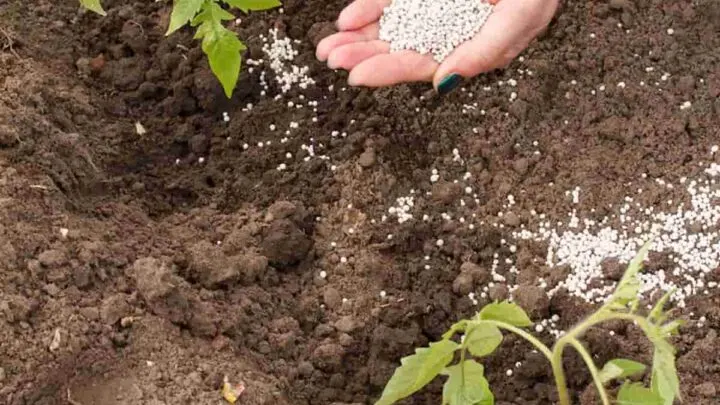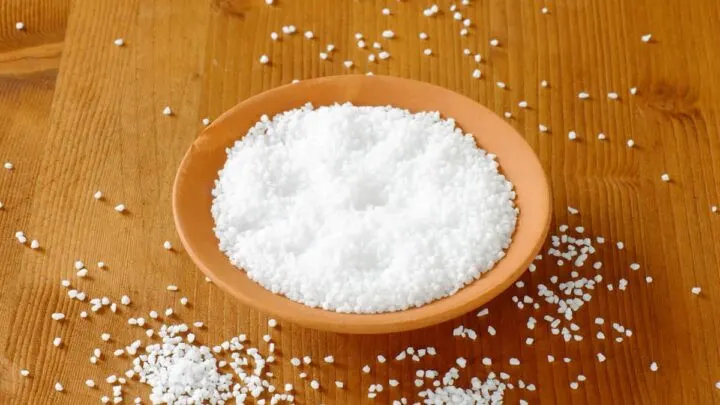Everyone loves the taste of a fresh-picked ripe tomato from the garden; there’s nothing like it. Yellow leaves, blossom end rot, and short, stunted growth can plague home-grown tomato plants. Will putting Epsom salt on tomato plants help?
In some cases, Epsom salt can help tomatoes grow. Epsom salt contains magnesium, which tomato plants need to thrive. However, there needs to be a balance of the additional micronutrients in the soil to grow healthy tomato plants.
Now that you know that it might be advisable to supplement your tomato plants with Epsom salt, you might have more questions. Read on to determine when it is and is not beneficial to add to your garden, how to apply it, and more.

Should I Put Epsom Salt on My Tomato Plants?
There are many gardening articles recommending that you apply Epsom salt to your tomato plants. The claim is that this will result in:
- Improved seed germination
- More vigorous plants
- Enhanced plant growth
- Larger tomatoes
- Redder and better-looking tomatoes
- Sweeter and juicier tomatoes
But is this true?
What Is Epsom Salt?
Epsom Salt is also known as magnesium-sulfate, a combination of magnesium and sulfur minerals. Both of these are important for the health and development of tomato plants. They are necessary for chlorophyll production, photosynthesis, and the production of proteins and enzymes.
Does My Garden Need Epsom Salt?
Tomato plants need the minerals Epsom salt contains. But your tomato garden may not need more than is already in your soil. All but the poorest of soils contain enough magnesium for your tomatoes.
A soil test can detect a magnesium deficiency, so you’ll know if you need to add Epsom salt for your plants. It will also measure the amounts of other essential micronutrients, such as calcium, nitrogen, phosphorous, and potassium. These, along with magnesium and sulfur, must be balanced so your tomato plants will thrive.
Excessive use of high-potassium fertilizers can result in plants being unable to take in enough magnesium efficiently. And too much magnesium can interfere with the absorption of the other micronutrients.

How Can Epsom Salt Help Tomatoes?
There are several ways that magnesium and sulfur benefit and help solve problems with tomato plants. By adding Epsom salt to your soil when it’s needed, you’re increasing your plants’ chances of thriving.
Reduce Yellowing in the Leaves
Chlorophyll production is what makes the leaves green. It’s dependent on magnesium, and a deficiency over time will cause leaves that are yellow with noticeable green veins. This is called ‘interveinal chlorosis.’
If the plant can take in more magnesium, the leaves and plant will be healthy again. Supplementing the soil with a small amount of Epsom salt is a way to increase the plant’s magnesium absorption.
Enhance the Taste
A healthy plant will produce better-tasting tomatoes than a weak one. Magnesium is essential in photosynthesis, and sulfur helps produce proteins and enzymes. Having sufficient amounts of both enables the plant to produce red, flavorful tomatoes.
Promote Growth
When a plant receives all the nutrients and sun it needs, it grows tall and full. Photosynthesis is the process of converting sunlight into energy. Without enough magnesium, this process is inhibited. The plant won’t have enough fuel to grow even if it receives all the sunshine it requires.
Aid Nutrient Absorption
Magnesium helps the tomato plant use other nutrients in the soil, such as nitrogen and phosphorous. Nitrogen is essential for plant growth, and phosphorous is used to produce flowers and fruit.

What Can’t Epsom Salt Do for Tomatoes?
Even though many sources recommend adding Epsom salt to your tomato plants, the basis for some of these claims isn’t evidence-based. Here are reasons not to use it.
Preventing Blossom End Rot
Blossom end rot is a condition when the bottom part of the tomatoes rot before they’re ripe. It starts with spots that look like bruises on the blossom end of the fruit. As they grow, they become dark and sunken in.
This is due to the plant being deficient in calcium. Blossom end rot is most commonly caused by drought, uneven watering, or saturated cold soil, inhibiting calcium absorption in the soil.
You will hear that Epsom salt can prevent this condition when, in reality, it can worsen it. The excess magnesium competes with the available calcium in the soil. The plant absorbs too much magnesium and thus does not have enough calcium.
Improve Seed Germination
Seeds contain all they need within to sprout and start to grow. They don’t need help from Epsom salt in the soil for that.
Transplants and seedlings can benefit from adding magnesium in Epsom salt if your soil does not contain a sufficient amount.
Feed Tomato Plants Appropriately
Epsom salt may be recommended as a fertilizer for tomatoes. Due to the magnesium content, this sounds good, but there is more to the story.
As noted previously, if your soil isn’t deficient in magnesium, you may do more harm than good by adding Epsom salt to your tomato plants. Also, magnesium is a micronutrient, meaning only a small amount is needed.
The other necessary micronutrients – nitrogen, calcium, potassium, and phosphorous – are also required. They all need to be in balance for your plants to flourish.
What may be more effective is to use a general fertilizer, which contains all of them. An alternative to that is well-rotted compost applied as a mulch. As it gets incorporated into the soil, it will improve its composition. Compost contains most of the nutrients your tomatoes need.

Discourage Pests
Many methods of natural pest control are out there, with varying promises of success. Some will work, some won’t. Research into using Epsom salt for repelling tomato pests such as grasshoppers and caterpillars has not found evidence that it’s worthwhile.
There also hasn’t been any proof of its effectiveness against tomato diseases.
It’s best to use a conventional method for these issues.
How Do You Use Epsom Salt on Tomatoes?
By now, you’ve seen that using Epsom salt to improve your tomato plants can yield results in some instances. And that it isn’t always the appropriate remedy for your problems.
But if it will be helpful in your situation, here is how to apply Epsom salt to your tomato plants.
If the problem is yellow leaves, spoon one tablespoon into a sprayer with a gallon of water and mix. Spray the mist on the leaves. Avoid spraying on a sunny day or before it rains, so there is time for the leaves to absorb it.
For other issues, add to the soil by mixing a small amount of Epsom salt into a watering can and water the plants.
For transplanting seedlings, you can either add a small amount to the soil before planting or add to a watering can and water them with that mixture.
Final Thoughts
As you’ve learned, adding Epsom salt without knowing if your plants need it can cause harm, perhaps damaging the roots. Noticing any leaf discolorations or rotting on your tomatoes can help you identify if you have a problem that indicates a magnesium deficiency.
Then you can do a soil test to check the balance of the nutrients your tomato plants need and supplement with Epsom salt or something else based on the results. If you can’t do a soil test, observe the symptoms and go from there.
Under the right conditions, adding Epsom salt to your garden soil will improve your plants’ health and vitality, resulting in flavorful tomatoes for you to enjoy.

Hi there, my name is Allie and welcome to my blog; GareningWithAllie!
Much of what you see written here is just our personal experiences with gardening. Along with the content I write here, there is also a unique collection of gardening topics covered by some of our close friends. I hope you find everything you read here to be helpful, informative, and something that can make your gardening journey the most lovely experience ever! With that said, Happy Gardening!
